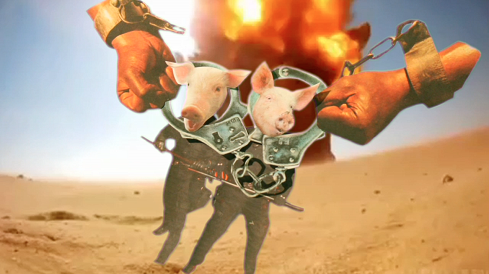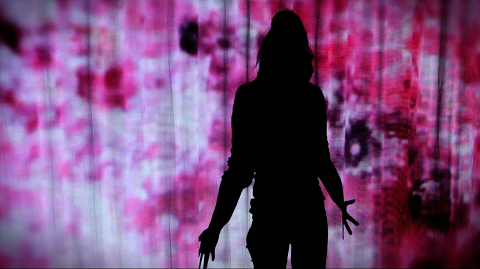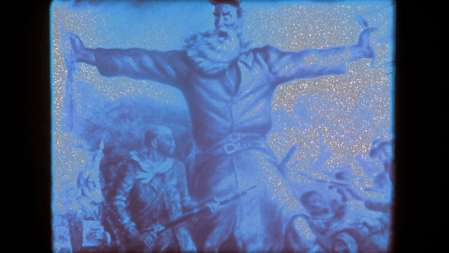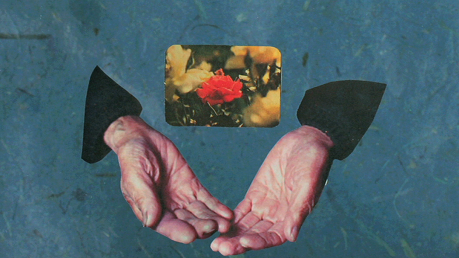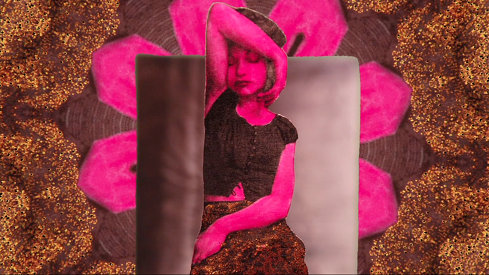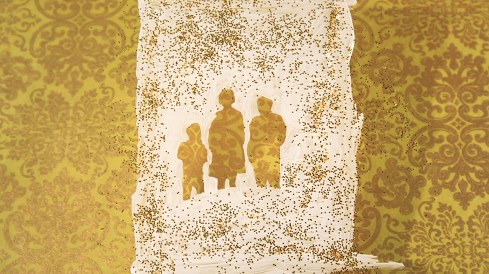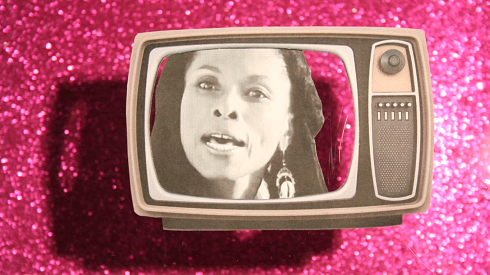by Kate Ewald
Kelly Gallagher is a radical experimental animator and filmmaker working in essayistic forms. Primarily dealing in hand-made practices, Gallagher focuses on intimate, occasionally difficult reactions to systematized injustice and personal experience. Gallagher is an Assistant Professor of Media Arts at Antioch College and holds an MFA in Cinematic Arts from the University of Iowa and a BA in Film/Video from Penn State. She is a Managing Editor at Now! A Journal of Urgent Praxis, a hybrid online publication featuring radical video and writing on current political cultural life. Her work has been shown internationally at Anthology Film Archives, MassArt Film Society, PhilaMOCA, Northwest Film Forum, Other Cinema, Festival de Cinémas Différents et Expérimentaux, Fronteira Festival, Ann Arbor Film Festival, and many (MANY) more.
I first met Kelly in the summer of 2014 after hosting a stop on her Women With Knives animation tour with Lauren Cook and Charlotte Taylor in Baltimore. Since then, we have spoken at length about the more political issues her work explores. This aspect of Kelly’s work has since been discussed in other publications at length, and I urge you to seek out these other interviews and features as a primer for the conversation below. A list of previously published interviews is listed as a footnote below. Nearly all of Kelly’s works are available for free on the internet, so I’d also suggest watching those videos as a companion experience. This interview with Kelly took place via e-mail in March of 2015 and January of 2016 as a way to explore some themes in her oeuvre that have been left untouched by the plethora of other writing about her work.
KE: Your work largely leans toward political subject matter. Do you think moving images – specifically animated moving images – lend themselves particularly well to this type of work? What are the obstacles?
KG: I definitely think animation lends itself very well to political subject matter, for a few different reasons. For one, I use collage extensively with my cut-out animation work. Collage is great because it can bring together seemingly disparate images and, in doing so, forces the viewer to be a more critically thinking viewer, since they need to work to make connections between the different images coming together being juxtaposed on screen. As Jacques Rançière says, “Collage can present itself as that which brings to light the hidden link between two apparently foreign worlds…” This worked specifically well for me in Pen Up the Pigs, because I wanted to juxtapose images of slave owners with present day police officers. During my archival image research, I was so struck by the horrific similarities in their poses, from the images of historical slave owners beating slaves to images of present day police officers beating black people in the United States.
Also, collage or cut-out animation and the other handcrafted animation techniques that I employ all make apparent their construction on screen. There is no CGI magic – on the contrary, the labor of the animator is not hidden, it is brought out into the light. My materials are clearly understood and apparent on screen from the paper cut-outs I use to glitter to oil paint, etc. This is important to me and I think is a sign of the radical politics of handcrafted animation because it is a mode of filmmaking that is far more accessible to the masses than other modes of filmmaking. This is imperative for me because like Walter Benjamin in his essay “Author as Producer,” and like Espinosa in his “For an Imperfect Cinema” manifesto, I think it’s important that art and cultural production be something available to the public at large. If an audience member can see my film, and by just watching it they gain an understanding of how I made the film, that means that the audience member could easily move from viewer to “producer” themselves. Because handcrafted and experimental modes of animation make their constructions apparent, this also gestures back towards the filmmaker as laborer and worker. Capitalism works to conceal the human relations of production. The spectacle and magic of CGI is so great that we often are just swept up in it (if it’s “good” CGI). We don’t think about the workers behind those animation effects, or even have any idea that those visual effects artists all lost their jobs because of the film’s exploitation of their labor. The magic of stop motion and handcrafted animation often points back to the artist, reminding us that the artist is a worker and labored over this production. We are reminded that the animator is present in the filmmaking process, and it makes us aware and understanding of them as worker and laborer, which I think is important.
Lastly, another reason I think that animation is well suited to explore political struggle is because so much of our life experiences have internal aspects- our emotions, our thoughts, our dreams, etc. Animation is able to bring to life and illustrate the unearthly, the internal, the otherworldly and the hidden aspects of our lived experiences.
I think the biggest obstacle to animation being used more often for political purposes is that many people grow up with the thought that animation is best suited for children and child-like explorations. It’s hard to think about the radical possibilities of an art form, when your whole life you are socialized into understanding it as the way you spend Saturday mornings with cartoons. Luckily, more and more experimental animators are doing the important work of making their films more accessible and available to audiences and the greater public at large! Even in the past decade alone, there has seemingly been a serious rise in animation happening within the experimental film world, in regards to experimental animation program curating, experimental animation tours, organizations, sites, networks, etc. I think the fact that technology and stop motion animation applications are becoming increasingly accessible to the public at large are also factors that are helping people branch out beyond the outdated notion that animation = children.
KE: Could you relate Marxist ideas of labor, production, and the fetishism of commodities to the production of cinema and animation, specifically as it relates to women? Do you think there’s a correlation between labor, gender, and cinema?
KG: Lately I’ve been specifically reflecting on the question of women working in experimental animation as a space of refusing reproductive labor. Women working in handcrafted and experimental animation practices, predominantly working within the home, refuse with each crafted frame – each 1/24th of a second – reproductive labor, if even only for that moment. While animating, we are momentarily refusing reproductive labor within our domestic space, creating art for ourselves and our community while reflecting on productivity itself – hyper-reflecting on time, contemplating and exploring creatively the tiniest fractions of seconds of our labor power and giving witness to all it produces. In taking an hour or two or three off/away from or refusing the reproductive labor of housework and domestic chores, which is inevitably work that fuels capital and capitalism, we instead create artwork (handcrafted animation) that emphasizes time and reflects the power of our hands and all they can create. That connects us to large communities of women animators networking and aiding one another. I think it can be really powerful to reflect on the power of what our hands can do and create and make.
This question also has me reflecting a bit on Hito Steyerl and this great short introduction she made once at a screening where she brought up the affective labor of women at the editing desk in early cinema production, asking why Man with the Movie Camera isn’t instead titled The Woman at the Editing Desk. This question is prompted by the fact that the brilliant editing of the film, done by Elizaveta Svilova, is arguably the true essence of what makes the film as great as it is. I also then of course reflect on Elisabeth Thuillier and all the women who made the early hand-painted the films the true magic that they were. I think there absolutely is a history of the affective or invisible labor of women in cinema that continues through to today.
KE: Which women animators are your favorite and why?
KG: This is a very difficult question because there are SO many! Martha Colburn’s work has always been my favorite. Her animations are fierce, powerfully political, and creative, and inspire me all the time. I am blown away by the work that Stacey Steers does with her intense and detailed collages. I’m a huge fan of Kelly Sears’s work and the way she appropriates and reworks images for her political explorations. Ng’endo Mukii’s mixed media animation work is explosively powerful. I really enjoy Lauren Gregory’s oil paint animations and her sense of humor in many of them. I’m amazed by Charlotte Taylor’s handcrafted 16mm stereoscopic film with a handmade polarized 3d mirror system, Edge of Summer. I’ve been really enjoying the direct animations of Jennifer Reeves and Jennifer West recently. I just saw Karen Yasinsky’s I Choose Darkness for the first time and was absolutely FLOORED by her masterful use of light and cinematography. I am so in awe of her films. I’ve also gotten into watching some oil and clay paint animations recently, and really love work by Lynn Tomlinson and Martine Chartrand. So many amazing women animators, I could go on all day!
KE: Do you think more experimental animators are women versus men now than in previous eras?
KG: I definitely know and am connected to far more women making experimental animations than men. It is nice to see a field of filmmaking right now where it feels like women are dominating, because at the origins of both cinema and experimental animation, men have been predominantly taught and featured and placed within the “canon” of animation. For example, the earliest camera-less animators most known and celebrated are folks like Len Lye and Norman McLaren. Many people don’t know that behind many of McLaren’s most well-loved and well-known animations was Evelyn Lambert, who is often not accurately credited for her co-production of those films. Many people don’t know that before any of those folks were around, Mary Hallock-Greenewalt was making the earliest (known to still exist) hand-painted films. People revel in awe at the sight of the hand-painted A Trip to the Moon “by” George Méliés, without knowing that the hand-painted, frame by frame work that makes that film so impressive was done by Elisabeth Thuillier and her hand-painting color team of over 200 women and girls. Edison’s famous film Annabelle Serpentine Dance, is believed to have been hand-painted by a wife of one of his workers. So there’s this history of women’s handcrafted work that’s often brushed aside, ignored, not taught, and not treated as equally important as the cult of the male director for those films. So I think it’s really important to draw these herstories into the light, and also celebrate this contemporary moment that we’re seeing now where women are totally pushing the boundaries and pioneering new techniques in experimental animation. I don’t think it’s that women were ever not as interested in animating as much as men in previous eras. I just think historically, women’s animation work – especially post-production animation and visual effects work – has been so terribly written out of mainstream animation history books.
KE: What advice would you give aspiring women animators?
KG: My advice is: always keep going, keep going! I think animation can be difficult in ways that live-action filmmaking is not, because in many cases, animation is a very intimate artistic act. Many experimental animators work by themselves, which means that animators have to be incredibly self-motivated and strong-willed to push through the difficult moments that inevitably arise during a production. It’s so important that more and more women continue to keep animating, and that we continue sharing our thoughts, ideas, and experiences in this medium because it lends itself so well to exploring our political and personal lives.
KE: Do you think women experimental animators have a unique perspective?
KG: Absolutely. I think women, people of color, the LGBTQ community – all groups that face systems of oppression – have perspectives that need to absolutely be continually shared, and shatter the cultural hegemony and the mainstream film industry. Experimental animation is a specifically great realm to be working within because it’s a very intimate mode of filmmaking and I think there’s some important safety in that. It’s a safe space to test creative ideas out, to learn more about yourself and your own interests, and learn more about tangible ways in which you can formulate and literally share and shape your stories, ideas, histories. To handcraftedly animate a film exploring your struggles or stories of resistance – there’s a politics to that. To literally and tactically shape and mold your story is very important, especially when your stories and struggles are so often swept aside or ignored. As Benjamin says, “the hand is a political organ.”
KE: What can women filmmakers do to fight injustices through their work?
KG: I think there’s a lot that women filmmakers and animators can do, and a lot of it starts with us coming together to share our experiences of sexism within whatever realm of filmmaking we’re working in. Yes, sexism exists in the experimental film world and documentary film world and animation film world. Yes, we need to band together, learn how to call out and check instances of blatant (and covert) sexism and racism whether we experience it on a personal level or structural level. For example, if we’re working with people to curate an experimental film program and we notice the line-up is all white men filmmakers… that’s a problem. Women filmmakers need to network and collaborate with each other, consistently work together to get more work shown by women and people of color, learn and share the histories/herstories of marginalized filmmakers and draw them out into the light, and fiercely call out sexism and racism as soon as we witness or experience it happening.
KE: Do you think it’s possible for contemporary experimental women filmmakers’ work to (mistakenly or accidentally) reinforce patriarchal thinking within the medium?
KG: This is interesting because it forces us to think about how we define contemporary “experimental filmmaking.” I think if we believe contemporary experimental filmmaking is a space for people who are wanting to continue pushing the boundaries of filmmaking in unconventional and conceptually forward-thinking ways, then I’d hope that people drawn to experimental filmmaking practices are themselves forward-thinking and radically progressive. In general though, of course there are folks of all genders who have terrible or reactionary politics that sadly reinforce patriarchal thinking in their art, films, writing, etc. But I like to hope that people drawn to experimental filmmaking practices are people who want to actively work against the political and patriarchal problems of more mainstream film industries and modes of filmmaking.
KE: Why do you think fewer men in the current cultural climate gravitate toward experimental animation?
KG: Experimental animation kind of feels like this magical, alternative universe where one can escape the sometimes hyper-aggressive, macho, cult-of-the-male-director bullshit that sometimes pervades live-action filmmaking spaces. I don’t know if it’s that men aren’t gravitating toward experimental animation – I know many amazing men experimental animators – I just think that there’s an overwhelming interest in experimental animation from women. I also think that live-action commercial film studios have hierarchical and patriarchal structures, and of course many commercial animation studios do as well. So, experimental and more intimate animation practices are places where women can really truly explore their artistic inclinations and create innovative and arguably far more interesting than CGI visual animation languages and techniques to tell their stories. I think experimental animation is very political because the means of production are generally very accessible. If women are pushed out of or don’t want to deal with sexist and consumerist and capitalistic animation studios, then experimental animation is ready, waiting, and accessible to them.
KE: In your 2011 film The Herstory of the Female Filmmaker, you detail the inequality and injustice that women endure within the film industry. Where are we today? Are things getting better?
KG: I feel like every time I see an info-graphic or new study trying to assess inequality for women in the film industry, it’s always depressing. A lot of these studies, however, focus mostly on Hollywood. For example, in 2013, Indiewire did some studies looking at percentages of women directing the top 250 films for various years. It seems that there are minor ebbs and flows. In 1998 and 2012, women directed 9% of the top 250 films those years. But in 2011, women directed only 5% of the top 250 films. So overall, things generally feel fairly stagnant and constantly problematic. While I think it’s awful that these issues of inequality continue to persist in the Hollywood system, I’m also not that surprised. It’s Hollywood, the most capitalistic, imperialistic, sexist, racist perpetuator of media. From making and celebrating white savior films to hosting award ceremonies like the Oscars where there have been rape jokes and homophobic, sexist, and racist comments by hosts. The mainstream film industry is egregious. It’s founded on capital and its ability to make money. So while I think that fighting sexism and racism in the mainstream film industry is important, I also think that we need to think politically and strategically about other spaces where we can make films that challenge Hollywood and critique Hollywood or mainstream modes of creation. This is of course what draws me, and I think many others, to experimental filmmaking. We need to fight against all injustices that women endure within the film industry. We also need to think politically, and understand how industries like Hollywood function and what their role within the larger capitalist economic system is, and we need to demand and take other spaces and forms of access to filmmaking and film production. This is why women supporting each other in all realms and modes of filmmaking is so incredibly imperative. We must work together and demand and take spaces and access to film production for ourselves, since no one is giving those things to us, and since entire media industries run on the exploitation of women and people of color.
KE: How do you see teaching, editing, and writing as extensions of your art? Your political action? What “non-artistic” organizing and activism have you been up to lately?
KG: I definitely see writing and editing as extensions of my art because I think that praxis is really important and useful for me. It’s helpful for me to always be reading and learning and thinking theoretically through what I’m doing creatively, artistically, and tangibly. As for teaching, I’m not sure if it’s an extension of my art necessarily, but I just really enjoy the hell out of it. Getting to explore with students all the wonderful possibilities of animation and filmmaking that I love is the BEST. Everyday I get to talk about all my favorite things and also always constantly be learning. Someone once told me “to teach is to learn” – and I think that’s very true. I think we need to think about teaching politically – so working to dismantle the patriarchy in our media courses, openly discussing the sexism and racism of the canon, working to emphasize media makers who are not written in the textbooks, creating new and anti-racist, anti-sexist textbooks ourselves when what exists already is failing us, etc, etc.
As for non-artistic political work I’ve been up to lately—in my small town here in Ohio, our community council was debating whether or not to approve keeping our local police department on this horrific regional drug task force. So a large group of us have been going to the town meetings and speaking up loudly and explicitly against the police remaining on the drug task force. The drug task force is of course incredibly racist and stems out of the terrible, structurally racist “war on drugs.” We’ve been fighting the police on this issue and just recently, FINALLY, found out that our efforts and organizing have paid off. Our local police department, thanks to the pressure of everyone in our community who spoke out and pressured our community council, will be leaving the regional drug task force. This is just one small step in a much larger process of political work that needs to be done, fighting the entire racist system of modern day policing in our community and all communities.
KE: Could you tell me a bit about your works in progress and what’s next?
KG: I’m currently working on a short animation exploring radical love and the innumerable love stories between revolutionaries. For example, there are these incredible, beautiful love letters between Karl Marx and Jenny von Westphalen and also letters between George Jackson and Angela Davis, and countless other revolutionary lovers. I think we sometimes forget all the aspects of the lives of revolutionaries outside of the political work we know them for. That’s my main project currently and it’s been interesting, because for the first time ever I’m exploring the use of some digital animation practices. So it will be interesting to see how the making of this film informs my theory and thinking-through of the digital and non-tactile realm of animation.
KE: You’ve been on a few recent tours now with your work (Denver, Chicago, Boston), meaning that you’ve had some time to see it in various spaces. In addition to your works in progress, how do you characterize the trajectory of your oeuvre? Do certain films play better in certain spaces?
KG: I hope, as I continue making films, that I will keep exploring the ways I can use animation as radically and politically as possible. In the past couple years I’ve begun dipping my toes into the realm of essayistic filmmaking and have found it immeasurably enjoyable and challenging. In similar ways that experimental animation elevates the spectator or audience to be able to see themselves as creators, so too I think does the essay film. In essay films, the filmmakers are exploratory as they personally reflect in some way on a question or problem. They bring themselves to the level of the spectator and in doing so allow space for spectators to understand themselves as creators too.
I’m not sure that certain films play better among certain audiences, but I have found that I most enjoy being able to show a mix of my more radically political work alongside my personal essay films. I think it does something useful in reading my work to view the juxtaposition of the incredibly personal films alongside the explosively incendiary and political ones. I’ve been very lucky and thankful for the amazing curators who have so kindly invited me out to share my work in their cinemas and spaces. The work of the curator is so incredibly political and important, and I am always endlessly grateful to those folks interested in sharing and screening more incendiary work.
—
Previous interviews with Kelly Gallagher:
– http://www.incite-online.net/gallagher.html
– http://www.indiegrits.com/meet-kelly-gallagher/
– http://www.animationmagazine.net/people/animation-with-a-mission/

